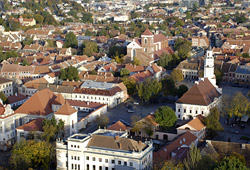History
Lithuanian Grand Duke Vytautas (c. 1350–1430) is believed to have founded a parish church in Kaunas that historical documents first mention in 1413. The parish of Kaunas at first belonged to the diocese of Vilnius, and as of the early 17th century, its church did not yet have basilica dimensions. It consisted of just the presbytery and an adjoining two-story sacristy. In fact, construction of the naves for the church began in the late 15th or early 16th century, when foundations were laid and walls began to rise. However, a shortage of funds disrupted the work, and the church stood incomplete for about 120 years. The work intensified after a fire in 1624, so that by 1655 the building had the form of a basilica, with massive towers, pillars, and a raised central nave.
Extensive renewal of the interior between 1771 and 1784 was financed with a grant from the Polish and Lithuanian ruler Stanislaus Augustus (1732–1798). Seven shining white brick altars were installed, a lectern and choir loft were added, as were numerous sculptures. The church’s interior acquired baroque traits. Following Lithuania’s loss of statehood and annexation by Tsarist Russia in 1795, the Kaunas parish church in 1808 became part of an Augustinian monastery. Bishop Motiejus Valančius (1801–1875) took control of the church in 1864, when Kaunas replaced Varniai as the administrative centre of the diocese of Samogitia. But it did not gain the status of cathedral until 1895. In preparation for that moment, between 1893 and 1895 the edifice underwent renovation. The Chapel of the Blessed Sacrament was built at the south end of the presbytery, and almost all the old paintings at the side altars were replaced by new ones painted by Mykolas Elvyras Andriolis (1836–1892).
The cathedral earned the title of minor basilica in 1921. In 1926, it became the “arch-cathedral” of the Kaunas Metropolitan Archdiocese, the primary see of the new Lithuanian ecclesiastical province created by Pope Pius XI. The mausoleum of the poet-priest Maironis (1862–1932) was added to the cathedral’s external south wall in 1935. Renovation in the late 1960s dramatically altered the sanctuary’s interior. All the sculptures and decorative elements were painted a dull grey or dismal purple colour. The resulting sense of gloominess was only fully eliminated during restoration work in 2008.
In 1997, the main altar was adapted to current liturgical norms, and in the year 2000, Cardinal Vincentas Sladkevičius (1920–2000) was buried in the Chapel of the Blessed Sacrament, in a tomb covered by a white marble slab. In 2001, a painting of Mary known as “Most Gracious Mother”, which has been renowned for special graces since the start of the 17th century, was transferred to the cathedral and hung over the altar at the first pillar on the left.








